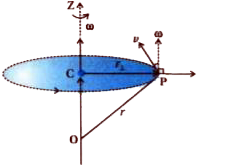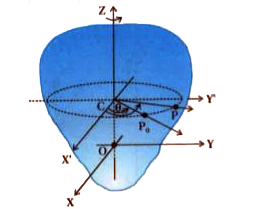Relation between linear and angular velocity for object in rotational motion is →v=→r×→ωSolution in Gujrati
The relation between the linear speed and angular speed of particle of rotation motion is v=rω, where r is the radius of circular path.
In general by any instant
vi=riω where i=1,2,3,….,n and n is the no. of particles in the rigid body.
If r=0,v=0, means particles on axis are stationary.

For obtaining the relation between linear velocity and angular velocity, a particle P of a rigid body rotating about Z-axis (fixed) as shown in figure. The position vector −−→OP=→r of particle at P on the rigid body with respect to the origin O. Its perpendicular distance is r1 from the centre C circular path.
Now →ω×→r=→ω×−−→OP
=→ω×(−−→OC+−−→CP)
=→ω×−−→OC+→ω×−−→CP
but →ω×−−→OC=ω(OC)sin0∘
[∵→ωand−−→OC are in same direction]
= 0
∴→ω×→r=→ω×−−→CP
but →ω perpendicular to the radius −−→CP and is parallel to the tangent of circle at P.
∴→ω×→r=→ω×−→r⊥[∵−−→CP=−→r⊥]
=ωr⊥sin90∘
[∵→ωand−→r⊥ are perpendicular]
=ωr⊥
but =ωr⊥ is equal to the magnitude linear velocity at point P
∴→ω×→r=→v
Is the relation between angular velocity and linear velocity.
The direction of →ω does not change with time for a rotating body about a fixed time but its magnitude change with time.
It the axis is not remain fixed, direction of angular velocity changes with time.
Hence, in general, for a rotating body the magnitude and direction of →ω changes with time.
Topper's Solved these Questions
- SYSTEMS OF PARTICLES AND ROTATIONAL MOTIONBOOK - KUMAR PRAKASHANCHAPTER - SYSTEMS OF PARTICLES AND ROTATIONAL MOTIONEXERCISE - SECTION-A HOTS
3 Videos
- SYSTEMS OF PARTICLES AND ROTATIONAL MOTIONBOOK - KUMAR PRAKASHANCHAPTER - SYSTEMS OF PARTICLES AND ROTATIONAL MOTIONEXERCISE - SECTION-A (TRY YOURSELF (VSQs))
94 Videos
- QUESTIONS ASKED IN JEE - 2020 BOOK - KUMAR PRAKASHANCHAPTER - QUESTIONS ASKED IN JEE - 2020 EXERCISE - Question
16 Videos
- THERMAL PROPERTIES OF MATTERBOOK - KUMAR PRAKASHANCHAPTER - THERMAL PROPERTIES OF MATTEREXERCISE - Question Paper (Section - D) (Answer following in brief :) Each carry 4 marks
1 Video
Similar Questions
What is torque? Explain the torque acting on a particle.
View SolutionWhat is a rigid body ? Explain the differences between rigid body and solid body.
View SolutionA non-isotropic solid metal cube has coefficient of linear expansion as 5×10−5/∘C along the x-axis and 5×10−6/∘C along y-axis and z-axis. If the coefficient of volumetric expansion of the solid is n×10−6/∘C then the value of n is....
View SolutionIn an experiment on the specific heat of a metal, a 0.20 kg block of the metal at 150∘C is dropped in a copper calorimeter (of water equivalent 0.025 kg) containing 150 cm3 of water at 27∘C. The final temperature is 40∘C. Compute the specific heat of the metal. If heat losses to the surroundings are not negligible, is your answer greater or smaller than the actual value for specific heat of the metal ?
View SolutionThe corresponding quantities in rotational motion related to m, →F,→pand→v in linear motion are respectively
View SolutionWrite relation between angular velocity and linear velocity,
View SolutionThe relation between linear velocity and angular velocity of a body moving in a circle is
View SolutionThe relation between linear velocity and angular velocity of a body moving in a circle is
View SolutionThe relation between linear velocity and angular velocity of a body moving in a circle is
View SolutionRotational Motion | Relation Between Angular Velocity And Linear Velocity
View Solutionकिसी कण के रेखीय वेग →v तथा कोणीय वेग →ω के मध्य निम्न में से कौन-सा सम्बन्ध सही है?
View SolutionRelation between linear and angular velocity for object in rotational motion is →v=→r×→ω
View SolutionEstablish a relation between linear velocity and angular velocity in a uniform circular motion and explain the direction of linear velocity
View SolutionExplain angular velocity and angular acceleration about fixed axis and derive the equation of rotational motion and write the analogy between the equations of linear motion and rotational motion.

View SolutionWhat is the vector relation between linear velocity and angular velocity in a uniform circular motion ?
View Solution